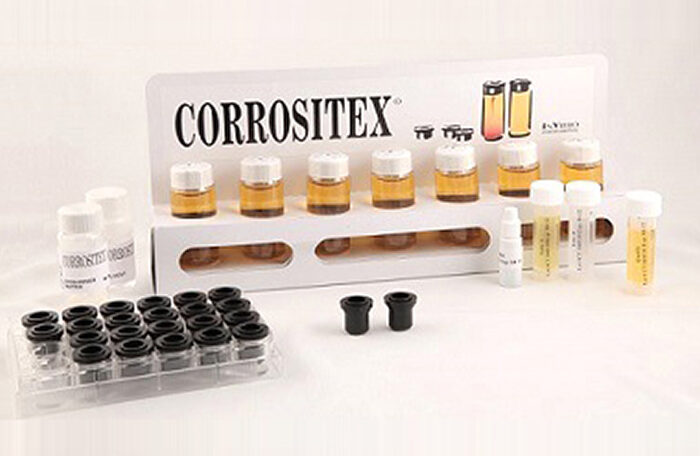 What is Corrositex®?
What is Corrositex®?
Corrositex® (OECD 435) is a non-animal test that determines skin corrosivity and provides GHS and U.N. PG classification for Class 8 corrosives and NON Corrosives. This test fully replaces the rabbit test for dermal corrosivity by providing a reliable means of mimicking that test. The proprietary core technology of the Corrositex® test is based upon a biomembrane and chemical detection system, which becomes colored when exposed to potentially corrosive substances.
You can purchase Corrositex® database Test Results online. Click here for more information.
How the Test Works
The Corrositex® testing system consists of a glass vial filled with a chemical detection fluid capped by a proprietary bio-barrier membrane, which is designed to mimic the effect of corrosives on living skin.

Click here, download the Corrositex Manual, contact InVitro for password
The Corrositex® test is performed in three steps. First, a qualification test is done to insure that the test sample and the Corrositex® Detection System (CDS) reagent are compatible. If a physical change or color change is observed, the sample is judged to be compatible with the detection solution and the remainder of the test is performed. The second step of the Corrositex® test utilizes appropriate indicator solutions to permit categorization of the test sample as either a Corrositex® Category 1 or Category 2 material. Corrositex® Category 1 materials are typically strong acids/bases, while Category 2 materials are typically weak acids/bases. The third step is performed by applying the test sample to the biobarrier. When the chemical permeates through or destroys the full thickness of this biobarrier, it comes into contact with the CDS which then undergoes a simple color change. Upon seeing the color change, record the elapsed time. After recording multiple membrane breakthrough times and averaging them, assign the appropriate GHS or UN Packing Group classification for regulatory inspection. Then, depending on their needs, they assign the proper GHS Category and/or U.N. Packing Group classification for U.S. DOT or EPA compliance, or use the data as a ranking tool or to substantiate marketing claims.
Why Use Corrositex®?
Because it’s regulatory approval will save you time and money.
- Corrositex® is the least cost, fastest and only in vitro dermal corrosives test which classifies U.N. Packing Groups I, II, III and NON-corrosive (& their GHS equivalents) with 96+% accuracy. This was found by the OECD (TG435) when they accepted CTX in the early part of the century.
- Time Savings: Unlike animal testing that can take many weeks, Corrositex® testing can provide a Packing Group determination in as little as 3 minutes and no longer than 4 hours.
- Cost Savings: In a recent evaluation, one customer saved up to $50,000 annually, in shipping costs, for a single compound when using the Corrositex® test to define the Packing Group instead of relying on pH. In addition to the reduction in shipping charges, additional cost savings are found in the areas of workplace safety and MSDS development.
Regulatory Acceptance
Following is a list of agencies that accept Corrositex. This list continues to grow as regulatory bodies look for more accurate, cost-effective and humane testing methods. Copies provided upon request.
United Nations (UN) GHS
Acceptance, Globally Harmonized System of Classification and Labeling of Chemicals (GHS). Fifth revised edition, UN New York and Geneva, 2013. P. 126 (d).
EU/OECD
Approval July 19, 2006
European Centre for the Validation of Alternative Methods (ECVAM)
12/2002
Department of Transportation – DOT-E 10904
Original exemption granted April 28, 1993
US DOT (PHMSA) Communication eliminating need for SP-10904
Transport Canada – Permit For Equivalent Level of Safety SU 4483
Original approval 8/14/96
Additional renewal 9/18/98
Additional renewal 1/15/01
Full Draize Replacement Acceptance 3/5/02
Occupational Safety and Health Administration (OSHA)
Letter of Interpretation dated March 3, 1994
Formal Acceptance, NIEHS press release dated 3/21/00
International Air Transportation Association (IATA)
Letter of acceptance dated December 17, 1993
EPA Federal Register / Vol. 60, No. 142 Dermal Corrosion Method 1120 June 13, 1997
Formal Acceptance, NIEHS press release dated 3/21/00
Consumer Product Safety Commission (CPSC)
Formal Acceptance, NIEHS press release dated 3/21/00

